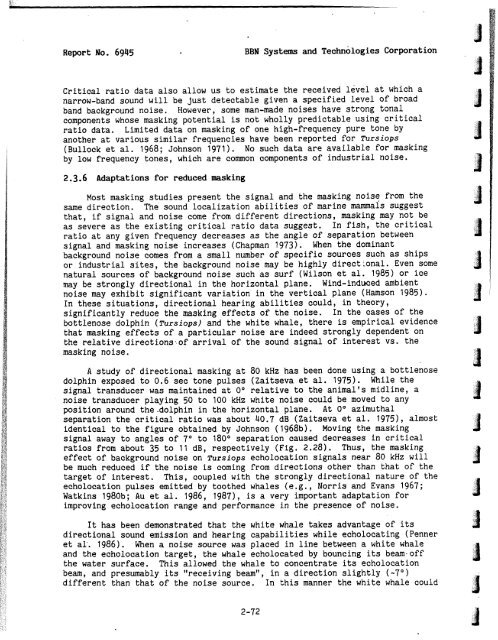Analysis and Ranking of the Acoustic Disturbance Potential of ...
Analysis and Ranking of the Acoustic Disturbance Potential of ...
Analysis and Ranking of the Acoustic Disturbance Potential of ...
Create successful ePaper yourself
Turn your PDF publications into a flip-book with our unique Google optimized e-Paper software.
Report No. 6945<br />
BBN Systems <strong>and</strong> ~echnologies Corporation<br />
Critical ratio data also allow us to estimate <strong>the</strong> received level at which a<br />
narrow-b<strong>and</strong> sound will be just detectable given a specified level <strong>of</strong> broad<br />
b<strong>and</strong> background noise. However, some man-made noises have strong tonal<br />
components whose masking potential is not wholly predictable using critical<br />
ratio data. Limited data on masking <strong>of</strong> one high-frequency pure tone by<br />
ano<strong>the</strong>r at various similar frequencies have been reported for Tursiops<br />
(Bullock et al. 1968; Johnson 1971). No such data are available for masking<br />
by low frequency tones, which are common components <strong>of</strong> industrial noise.<br />
2.3 -6 Adaptations for reduced masking<br />
Most masking studies present <strong>the</strong> signal <strong>and</strong> <strong>the</strong> masking noise from <strong>the</strong><br />
same direct ion. The sound localization abilities <strong>of</strong> marine mammals suggest<br />
that, if signal <strong>and</strong> noise come from different directions, masking may not be<br />
as severe as <strong>the</strong> existing critical ratio data suggest. In fish, <strong>the</strong> critical<br />
ratio at any given frequency decreases as <strong>the</strong> angle <strong>of</strong> separation between<br />
signal <strong>and</strong> masking noise increases (Chapman 1973). When <strong>the</strong> dominant<br />
background noise comes from a small number <strong>of</strong> specific sources such as ships<br />
or industrial sites, <strong>the</strong> background noise may be highly direct-onal. Even some<br />
natural sources <strong>of</strong> background noise such as surf (Wilson et al. 1985) or ice<br />
may be strongly directional in <strong>the</strong> horizontal plane. Wind-induced ambient<br />
noise may exhibit significant variation in <strong>the</strong> vertical plane (Hamson 1985).<br />
In <strong>the</strong>se situations, directional hearing abilities could, in <strong>the</strong>ory,<br />
significantly reduce <strong>the</strong> masking effects <strong>of</strong> <strong>the</strong> noise. In <strong>the</strong> cases <strong>of</strong> <strong>the</strong><br />
bottlenose dolphin (~ursio~s) <strong>and</strong> <strong>the</strong> white whale, <strong>the</strong>re is empirical evidence<br />
that masking effects <strong>of</strong> a particular noise are indeed strongly dependent on<br />
<strong>the</strong> relative directions.<strong>of</strong> arrival <strong>of</strong> <strong>the</strong> sound signal <strong>of</strong> interest vs. <strong>the</strong><br />
masking noise.<br />
A study <strong>of</strong> directional masking at 80 kHz has been done using a bottlenose<br />
dolphin exposed to 0.6 sec tone pulses (Zaitseva et al. 1975). While <strong>the</strong><br />
signal transducer was maintained at O0 relative to <strong>the</strong> animal's midline, a<br />
noise transducer playing 50 to 100 kHz white noise could be moved to any<br />
position around <strong>the</strong>.dolphin in <strong>the</strong> horizontal plane. At O0 azimuthal<br />
separation <strong>the</strong> critical ratio was about 40.7 dB (Zaitseva et al. 1975), almost<br />
identical to <strong>the</strong> figure obtained by Johnson (1968b). Moving <strong>the</strong> masking<br />
signal away to angles <strong>of</strong> 7O to 180° separation caused decreases in critical<br />
ratios from about 35 to 11 dB, respectively (Fig. 2.28). Thus, <strong>the</strong> masking<br />
effect <strong>of</strong> background noise on Tursiops echolocation signals near 80 kHz will<br />
be much reduced if <strong>the</strong> noise is coming from directions o<strong>the</strong>r than that <strong>of</strong> <strong>the</strong><br />
target <strong>of</strong> interest, This, coupled with <strong>the</strong> strongly directional nature <strong>of</strong> <strong>the</strong><br />
echolocation pulses emitted by too<strong>the</strong>d whales (e.g., Norris <strong>and</strong> Evans 1967;<br />
Watkins 1980b; Au et al. 1986, 1987), is a very important adaptation for<br />
improving echolocation range <strong>and</strong> performance in <strong>the</strong> presence <strong>of</strong> noise.<br />
It has been demonstrated that <strong>the</strong> white whale takes advantage <strong>of</strong> its<br />
directional sound emission <strong>and</strong> hearing capabilities while echolocating (Penner<br />
et al'. 1986). When a noise source was placed in line between a white whale<br />
<strong>and</strong> <strong>the</strong> echolocation target, <strong>the</strong> whale echolocated by bouncing its beam.<strong>of</strong>f<br />
<strong>the</strong> water surface. This allowed <strong>the</strong> whale to concentrate its echolocation<br />
beam, <strong>and</strong> presumably its "receiving beam", in a direction slightly (-7")<br />
different than that <strong>of</strong> <strong>the</strong> noise source. In this manner <strong>the</strong> white whale could
















